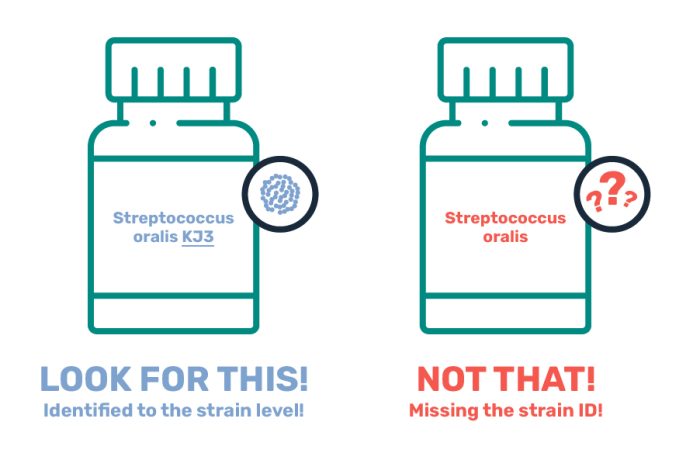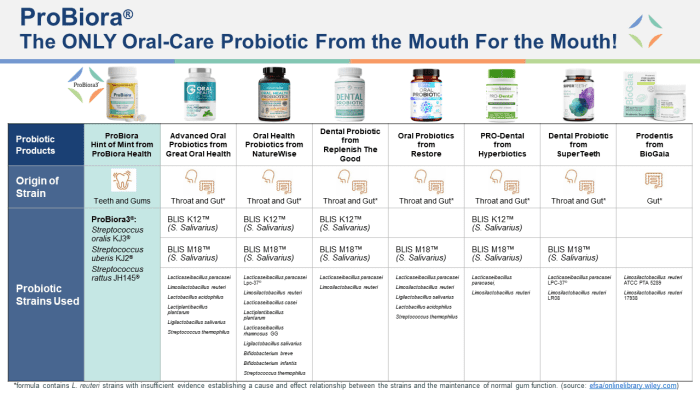ENJOY AN EXTRA 10% OFF YOUR FIRST ORDER
When you subscribe to ProBioraHealth.com emails
June 18, 2024
Probiotics have emerged as a game-changer for better oral health. Today, more than 25 companies market oral-care probiotics with over 50 different bacterial species and strains1. Many of these products contain bacteria that are designated by the U.S. Food and Drug Administration as “Generally Recognized as Safe” (GRAS). Typically, these bacteria receive GRAS status from a history of safe use in food products- think bacteria used as starter cultures for yogurt or cheese fermentation. However, just because a species or strain has been shown to be safe in food doesn’t mean that it will provide a health benefit in the body2.
As the oral-care probiotic market grows, dental professionals and consumers may be overwhelmed by the sheer number of probiotic products available. Conflicting, misleading, or confusing information supplied by competing product manufacturers can overshadow the science. And you should know- not all probiotics are created equal. At the heart of every probiotic product are the bacteria strains- and strains matter.
So, how do you navigate the confusing oral-care probiotics market to identify the probiotic strains that fit your health needs? Read our helpful tips below.
What questions should you ask when choosing a probiotic?
1. Does the product contain enough information about the probiotic microorganism?
Most probiotic microorganisms are bacteria. Bacteria are most often identified by their scientific name, in Latin, to either the species level (less information) or strain level (more information). Probiotic products should always contain bacteria names to the strain level because individual bacteria cells of the same species can contain different genes. Those genes can make the difference between providing a health benefit and having zero effect in the body.

2. Is a history of safety and effectiveness easily available for the listed probiotic strain?
Probiotic bacteria should have a history of safe use and they should have evidence to show that they support health. The best type of documentation for this information is peer-reviewed, scientific research. Peer-reviewed research is required to undergo rigorous scientific review from a panel of experts, ensuring accuracy. However, this information can be difficult for consumers and dental professionals to access and interpret. At ProBiora Health, we provide the peer-reviewed science that supports the safety and effectiveness of our probiotics in our Knowledge Library (link) and will happily share our research.
3. Does the probiotic strain provide a health benefit for the body area of concern?
Now that you’ve identified products that contain probiotic bacteria to the strain level and you’ve evaluated their safety and effectiveness, you need to figure out which specific strain will help with your health concern.
In the oral cavity, these health concerns may range from bad breath or yellow teeth to more serious issues such as cavities and gingivitis. While probiotics are not drugs and cannot claim to prevent, treat, or cure any disease, they can help reduce levels of bad bacteria that cause serious illness in the mouth. Use peer-reviewed science and clinically proven claims to choose a probiotic strain that will help with your specific oral concern.
What characteristics are essential for an oral-care probiotic?
If you’re looking for an oral care probiotic to help support healthy teeth and gums, the bacteria should have a few essential features:
ProBiora’s patented probiotic blend, ProBiora3®, contains three bacteria strains that were originally isolated from the teeth and gums of a healthy adult (read more about the history of ProBiora3 here). These bacteria survive and thrive on the teeth and under the gumline where they crowd out harmful bacteria that cause cavities and gum disease while restoring the mouth’s natural microbial balance. More than 35 years of peer-reviewed, clinical research support ProBiora’s benefits, which include:
ProBiora Health is the market leader for oral-care probiotics because ProBiora3 is the only probiotic blend that contains strains from the teeth and gums that directly support tooth and gum health.
Other oral-care probiotics only include strains of throat or gut bacteria- a critical difference, as bacteria lives where it will thrive. Only strains of good bacteria from the mouth will thrive in the mouth. Take a look at the chart below to see where the probiotic strains frequently found in other oral-care probiotics were originally isolated:

At ProBiora Health, we make it our mission to help you achieve brighter, healthier smiles- starting by choosing the right probiotic strains. Strains should be selected based on their ability to effectively support tooth and gum health and should be backed by scientific research demonstrating their effectiveness and safety in improving overall oral hygiene. For better oral health, choose ProBiora3 probiotics. You can be confident these strains will survive and thrive on the teeth and gums to provide maximum benefits for maintaining a healthy mouth
1. How, Y.-H. & Yeo, S.-K. Oral probiotic and its delivery carriers to improve oral health: A review. Microbiology 167, 001076 (2021).
2. Van Holm, W. et al. Probiotics for oral health: do they deliver what they promise? Frontiers in Microbiology 14, (2023).